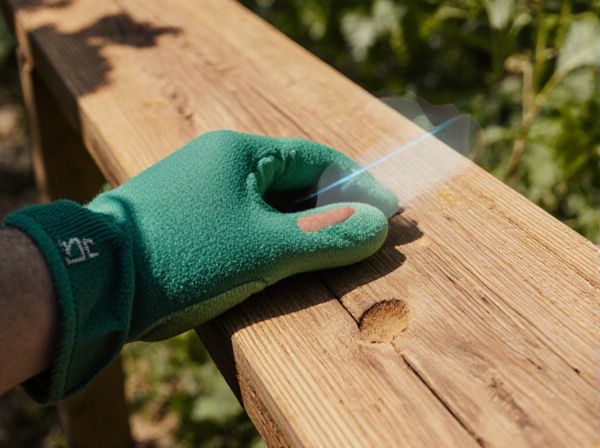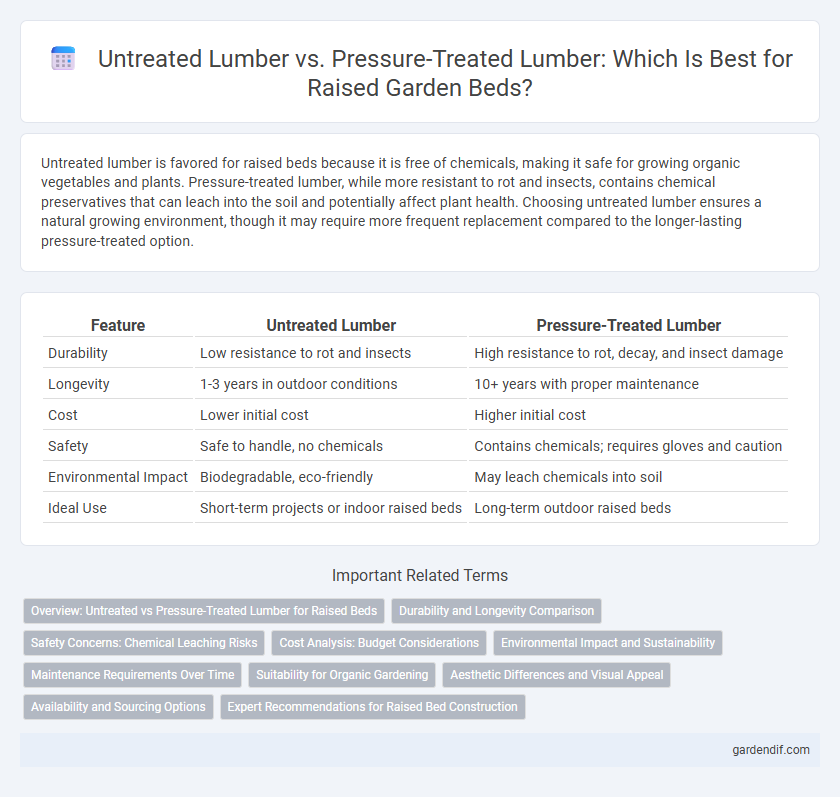
Untreated lumber vs Pressure-treated lumber Illustration
Untreated lumber is favored for raised beds because it is free of chemicals, making it safe for growing organic vegetables and plants. Pressure-treated lumber, while more resistant to rot and insects, contains chemical preservatives that can leach into the soil and potentially affect plant health. Choosing untreated lumber ensures a natural growing environment, though it may require more frequent replacement compared to the longer-lasting pressure-treated option.
Table of Comparison
| Feature | Untreated Lumber | Pressure-Treated Lumber |
|---|---|---|
| Durability | Low resistance to rot and insects | High resistance to rot, decay, and insect damage |
| Longevity | 1-3 years in outdoor conditions | 10+ years with proper maintenance |
| Cost | Lower initial cost | Higher initial cost |
| Safety | Safe to handle, no chemicals | Contains chemicals; requires gloves and caution |
| Environmental Impact | Biodegradable, eco-friendly | May leach chemicals into soil |
| Ideal Use | Short-term projects or indoor raised beds | Long-term outdoor raised beds |
Overview: Untreated vs Pressure-Treated Lumber for Raised Beds
Untreated lumber, typically made from cedar, redwood, or pine, offers natural resistance to decay and is safer for growing edibles due to the absence of chemicals. Pressure-treated lumber undergoes a chemical infusion process, enhancing durability and resistance to rot, insects, and fungal growth but may leach harmful substances into the soil if not properly sealed. Selecting between untreated and pressure-treated lumber for raised beds depends on balancing longevity, environmental safety, and the type of plants being cultivated.
Durability and Longevity Comparison
Untreated lumber used in raised beds offers a natural option but tends to degrade within 2 to 5 years due to exposure to moisture, insects, and soil conditions. Pressure-treated lumber is chemically infused to resist rot, insects, and fungal decay, extending its lifespan up to 20 years or more in garden environments. While untreated wood avoids potential chemical leaching concerns, pressure-treated wood provides superior durability and longevity, making it ideal for long-term raised bed construction.
Safety Concerns: Chemical Leaching Risks
Untreated lumber poses minimal chemical leaching risks, making it safer for growing edible plants in raised beds. Pressure-treated lumber contains preservatives like copper, arsenic, or other biocides that can leach into the soil and potentially contaminate crops. Ensuring safe gardening practices involves selecting untreated wood or opting for newer, safer treatment options labeled as food-safe.
Cost Analysis: Budget Considerations
Untreated lumber typically costs less upfront, making it a budget-friendly option for raised beds, but it may require more frequent replacement due to weathering and rot. Pressure-treated lumber has a higher initial cost but offers greater durability and longevity, reducing long-term maintenance and replacement expenses. Considering the total lifecycle cost, pressure-treated lumber can be more cost-effective despite the higher initial investment.
Environmental Impact and Sustainability
Untreated lumber is more environmentally friendly as it avoids the use of chemicals, making it biodegradable and reducing soil contamination risks in raised bed gardening. Pressure-treated lumber, although longer-lasting due to chemical preservatives, can leach toxins like arsenic or copper into the soil, potentially harming beneficial soil organisms and plants. Choosing untreated, sustainably sourced wood or alternative materials enhances long-term environmental sustainability and promotes safe, organic gardening practices.
Maintenance Requirements Over Time
Untreated lumber in raised beds requires frequent maintenance such as sealing and staining to prevent rot and insect damage, typically needing attention every 1-2 years. Pressure-treated lumber resists decay and pests longer, significantly reducing maintenance frequency, often stretching to 5-10 years before major upkeep is needed. Choosing pressure-treated wood lowers long-term maintenance costs and labor, making it ideal for durable, low-maintenance raised garden beds.
Suitability for Organic Gardening
Untreated lumber is often preferred for organic gardening because it does not contain chemicals that could leach into the soil and affect plant health or contaminate edible crops. Pressure-treated lumber, while more durable and resistant to rot and insects, typically contains preservatives such as copper compounds or pesticides that raise concerns about potential soil and plant contamination. Choosing untreated lumber ensures a safer environment for organic cultivation and aligns better with organic gardening standards.
Aesthetic Differences and Visual Appeal
Untreated lumber in raised beds offers a natural, rustic appearance that ages gracefully with weather exposure, developing a silvery-gray patina over time. Pressure-treated lumber often has a greenish or brownish tint due to chemical preservatives, which can appear less natural but provides longer-lasting durability. Gardeners seeking a more organic look typically prefer untreated wood, while those prioritizing longevity may accept the altered aesthetics of pressure-treated lumber.
Availability and Sourcing Options
Untreated lumber for raised beds is widely available at local lumberyards, garden centers, and home improvement stores, offering a variety of wood types such as cedar, pine, and fir, often sourced from sustainable forests. Pressure-treated lumber is also commonly accessible, primarily sourced from large manufacturers specializing in chemically treated wood, with availability depending on regional regulations due to environmental concerns. Choosing between the two depends on priorities like chemical exposure, lifespan, and ease of sourcing from trusted suppliers.
Expert Recommendations for Raised Bed Construction
Experts recommend choosing untreated lumber like cedar or redwood for raised bed construction due to their natural resistance to rot and chemicals, ensuring safe, chemical-free soil for organic gardening. Pressure-treated lumber, often infused with copper-based preservatives, is durable but may leach harmful substances into the soil, posing risks to sensitive plants and food crops. For optimal longevity and safety, specialists suggest sealing untreated wood with non-toxic, water-resistant coatings rather than using chemically treated materials.
Untreated lumber vs Pressure-treated lumber Infographic

 gardendif.com
gardendif.com